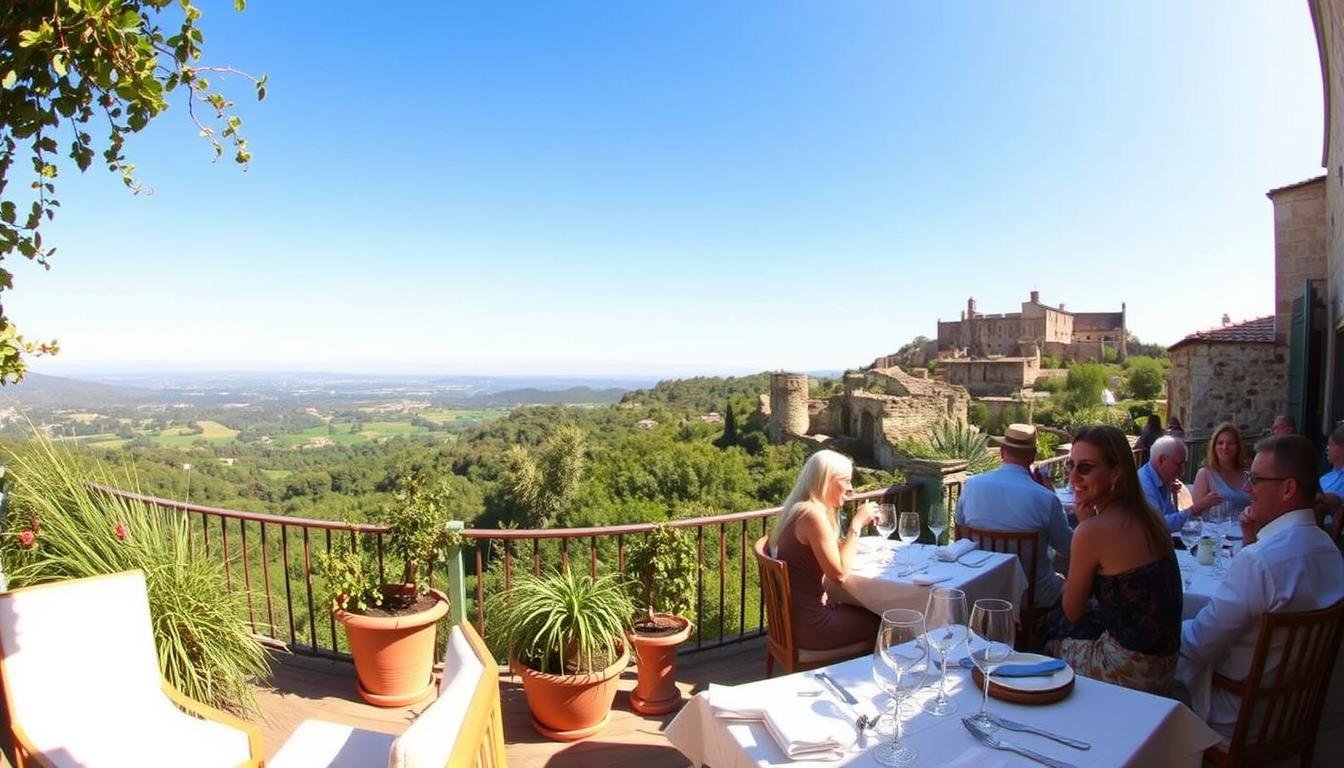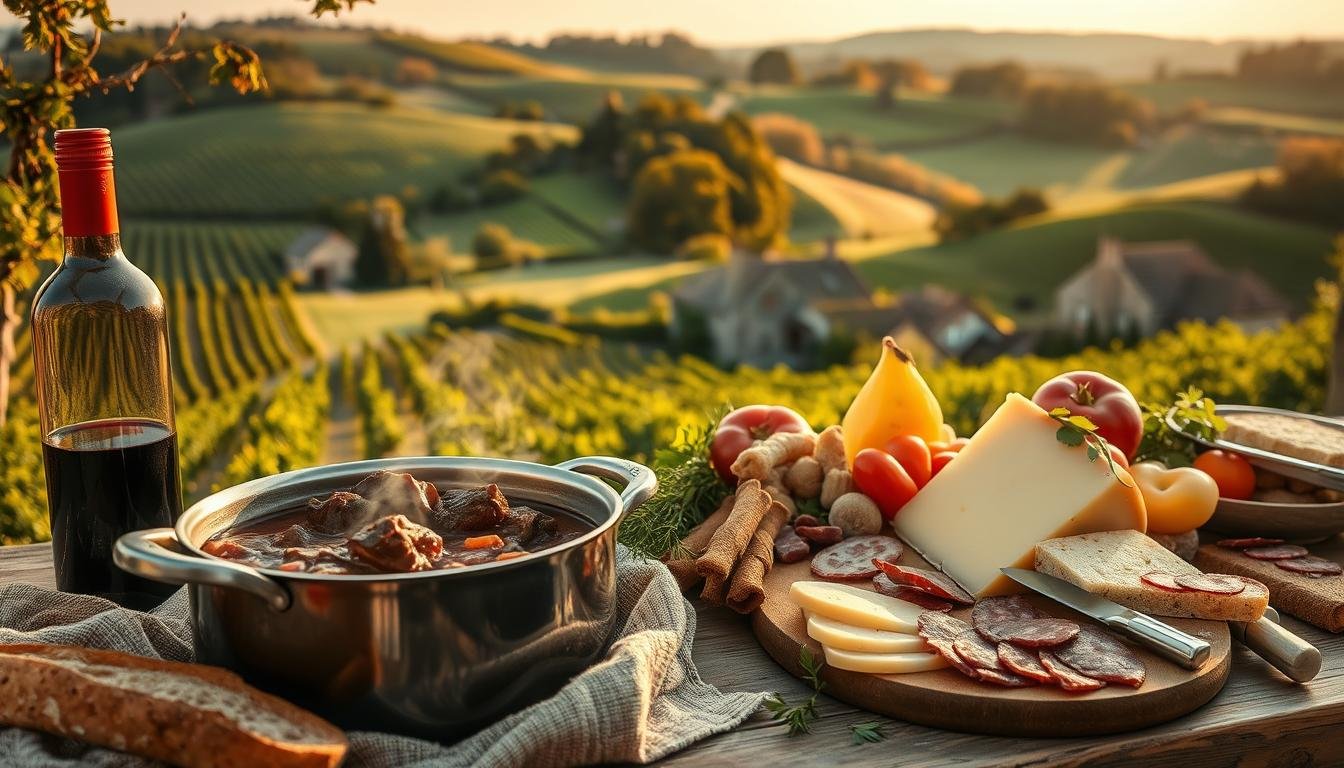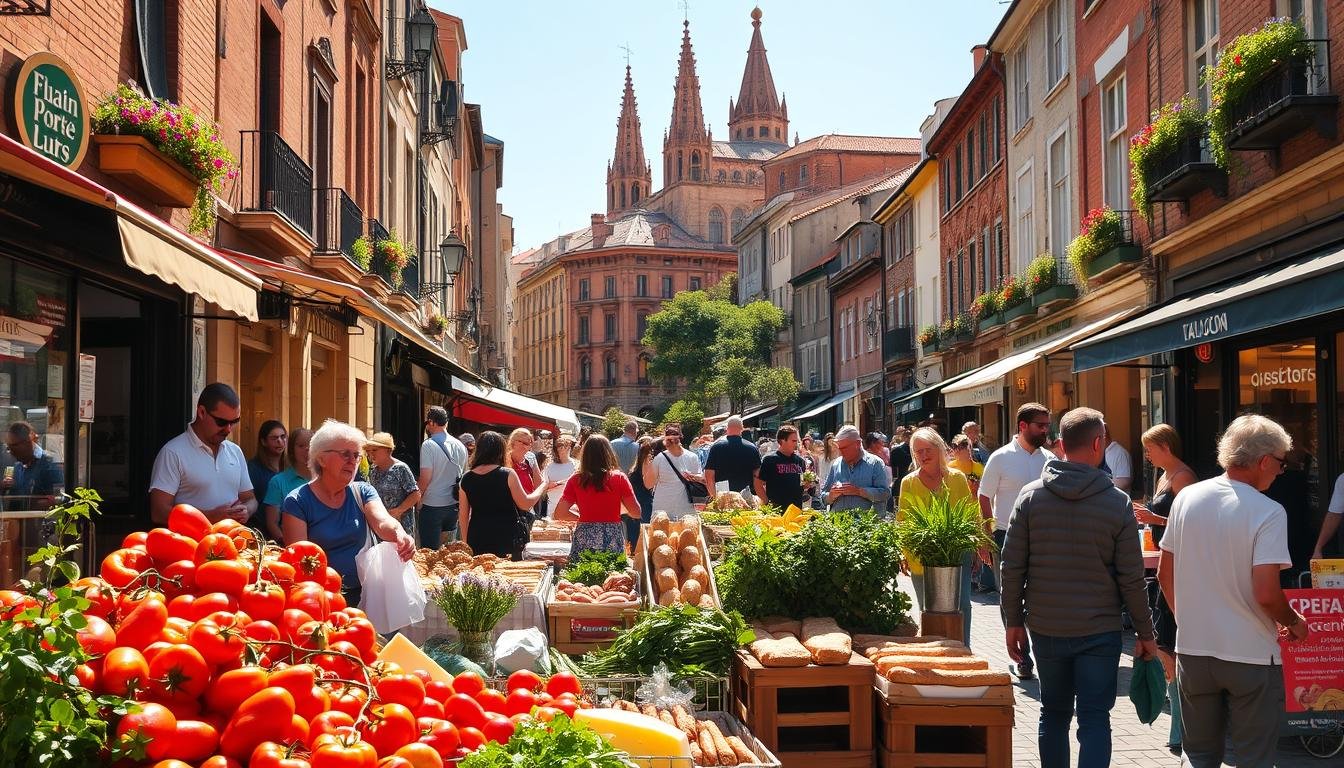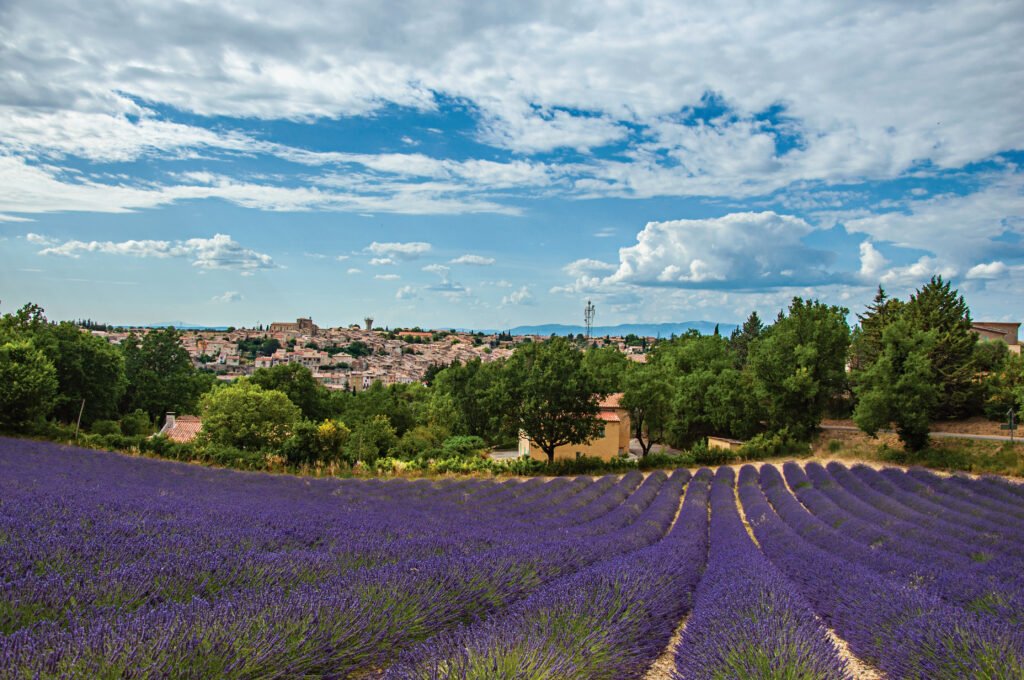
Les Baux-de-Provence sits atop a rugged limestone ridge. It offers more than just stunning views—it invites you to taste its soul. Your journey through this medieval village shows how French food here blends history with new ideas. Every meal is a conversation between the landscape and the chefs’ creativity.
Walking the cobblestone paths, you’ll smell rosemary and lavender. These scents are as old as the ruins nearby. Restaurants on cliffs serve dishes like bouillabaisse with Côtes du Rhône. Their tables offer views of the Alpilles mountains. This culinary tour of Les Baux-de-Provence France is more than just eating—it’s a story told through taste and terrain.
Key Takeaways
- Les Baux’s architecture and cuisine both reflect centuries of Provençal heritage.
- Panoramic dining in Provence offers meals matched to dramatic natural backdrops.
- Local ingredients like truffles and AOP olive oil define the region’s culinary identity.
- Michelin-starred chefs reinterpret traditional recipes using modern techniques.
- Seasonal markets and olive groves provide hands-on connections to Provençal flavors.
Ready to explore where every bite tastes like adventure? Let’s begin this journey through one of France’s most captivating culinary landscapes. Questions or custom itinerary requests? Contact our team at epicurean-escape.com/contact for personalized guidance.
The Gastronomic Appeal of Les Baux-de-Provence
Les Baux-de-Provence is a place where cliffs meet valleys. Its food story is like a family recipe. Every dish here is a tribute to simplicity.
Imagine olive oil on grilled veggies, rosemary lamb, and bouillabaisse with saffron. These are the flavors of the region.
A Brief Introduction to Provençal Cuisine
At its core, Provençal cuisine is about sunlight and limited ingredients. Niçoise olives, wild fennel, and garlic are key. They make dishes like socca and tapenade.
Walking through a bakery, you’ll see Italy’s influence. But Provençal dishes have their own twist. Think thyme lamb chops or lavender cakes.
How Geography Shapes Local Flavors
The land itself is a chef. Here’s how:
| Geographic Factor | Flavor Impact |
|---|---|
| Limestone soil | Sharper mineral notes in olive oil |
| Mistral winds | Concentrated herb aromas (thyme, rosemary) |
| Sun-drenched slopes | Ripened fruits and vegetables |
The Fusion of History and Modern Culinary Practices
In village kitchens, ancient and modern meet. Roman stone mills are next to sous-vide machines. Chefs like Jean-Pierre Moreau roast game birds in clay ovens.

They add edible flower garnishes. This blend of old and new creates dishes that honor tradition and embrace today’s trends.
Your Personal Culinary Tour of Les Baux-de-Provence France
Begin your culinary tour in Les Baux-de-Provence at dawn. The smell of wood-fired bread leads you to a hidden boulangerie. Monsieur Dupont serves you a warm baguette, its crust full of heritage. “Three generations,” he said, “no shortcuts.”
This baguette becomes your guide for the day’s food adventures in Provence.

Walking on cobblestone paths, You’ll come across a shaded terrace. Sunlight dance on a plate of ratatouille in earthenware. Each ingredient—eggplant, tomatoes—told stories of Provençal soil.
At a cliffside table, a sommelier pours a rose that mirrored the sky. “Le vin est l’âme de la table,” she says. That glass is a highlight of your journey.
“Every glass tells a story,” he murmurs, pouring a wine that taste of stone and sea.
Evenings bring unforgettable gourmet experiences. Aioli garni is so vibrant it startle tears. A truffle risotto dissolve like memory. Each moment is a discovery.
By day’s end, comes Les Baux’s magic. It’s in its contrasts—old traditions and new innovations. All set against the Alpilles’ beauty. This is more than a tour; it is a dialogue between hands and land, shared one bite at a time.
Clifftop Dining: Restaurants with the Most Breathtaking Views
Les Baux-de-Provence’s restaurants sit high above the Alpilles’ rough landscape. They turn meals into unforgettable experiences. Each dish is enhanced by stunning views, just as important as the food itself. Three places stand out, blending Provençal charm with breathtaking views.
L’Oustau de Baumanière: Michelin-Starred Excellence
At L’Oustau de Baumanière, two Michelin stars shine like the sunset over the Camargue. Chef Glenn Viel’s artichoke barigoule, with Château Simone white, tastes like Provence itself. The terrace, part of Provence’s Michelin elite, offers views of the Luberon hills.
Dining here is more than just eating. It’s a conversation between the food and the view.
La Cabro d’Or: Rustic Elegance Amid Olive Groves
La Cabro d’Or is set among ancient olive trees. The daube de boeuf, cooked with morning herbs, arrives as the sky turns amber. It’s like stepping into a Cézanne painting.
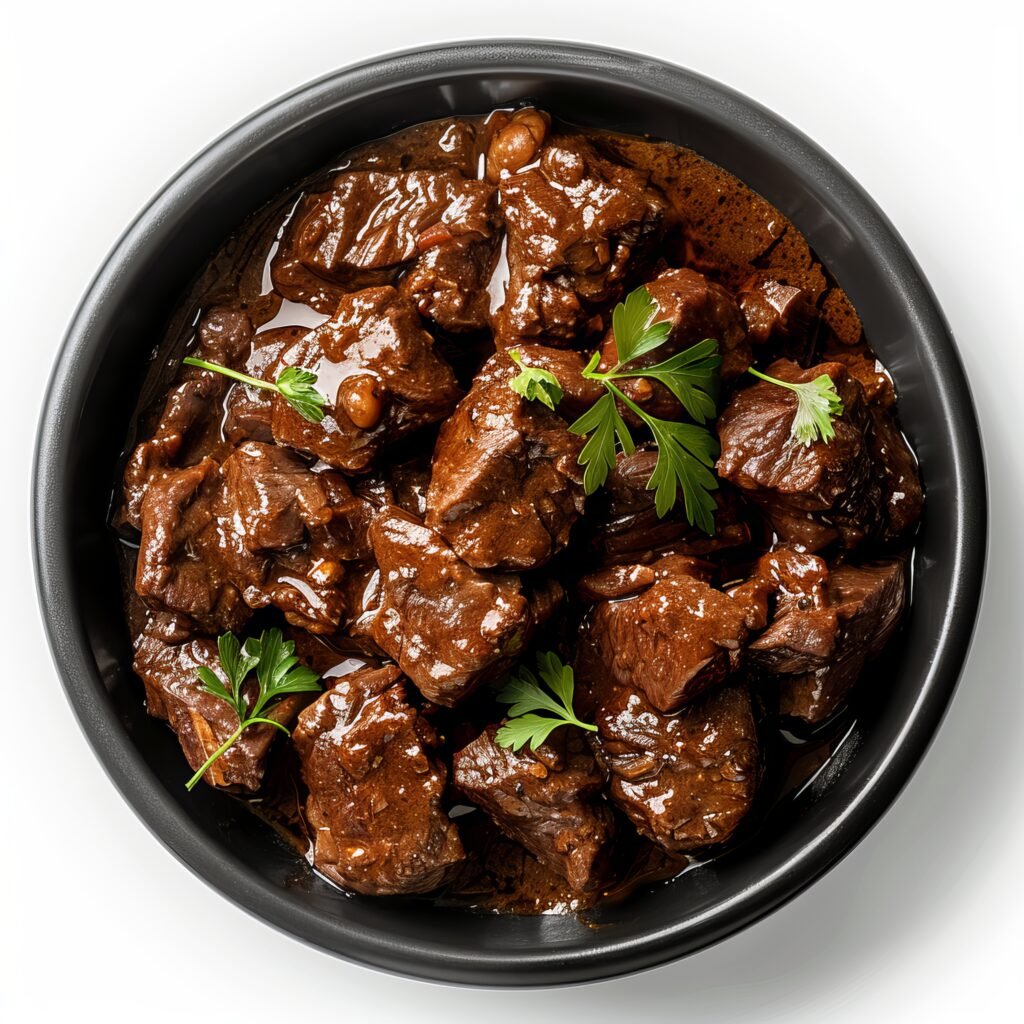
For those seeking similar experiences, Barcelona’s culinary scene offers something special. But Les Baux’s setting is unique.
Le Mas d’Aigret: Carved into Ancient Rock
Le Mas d’Aigret is carved from limestone. Dining here, with a Côtes de Provence, feels like time stands still. The “shepherd’s feast” of lamb and wild herbs is even more flavorful against the stunning backdrop.
Seasonal Ingredients That Define Les Baux Cuisine
Les Baux’s chefs see each season as a key ingredient. Your exploration of their markets and kitchens shows how seasonal French ingredients turn dishes into short-lived wonders. In spring, thin asparagus from local farms star in a simple yet elegant dish. It is topped with local olive oil and fleur de sel.

Summer brings a variety of produce to a farmer’s stand. The vendors encourage you to try every. Autumn’s forests offer wild mushrooms, whose rich flavor is used in soups by a chef who forages. Winter’s truffles, found early in the morning, are served over pasta, filling the kitchen with their aroma.
“The land gives what it give—we listen,” said the olive grove keeper, embodying the region’s philosophy. This respect for timing shapes every dish. Chefs here don’t follow trends; they let the seasons guide their menus, honoring a tradition that makes dining a conversation with nature.
At Mediterranean seasonal cooking festivals, people enjoy this harmony. The outcome? Meals that reflect the place and time, with each bite telling a story of Provençe’s land. It teaches you about patience: food at its finest, shaped by earth and sun.
The Olive Oil Legacy: Tasting Liquid Gold
Walking through sun-drenched groves, discover how AOP Les Baux-de-Provence olive oil becomes the soul of Provençal cooking. Each bottle holds centuries of tradition, from ancient groves to methods refined by generations.
AOP Les Baux-de-Provence Olive Oil: What Makes It Special
Its signature peppery finish isn’t just a flavor—it’s a testament to the region’s terroir. The Salonenque and Aglandau olives, harvested at precise moments, yield oils rich in polyphenols. During a tasting, a cruche of early-harvest oil reveals grassy notes that lingers like a whisper of the Mediterranean wind.
“The oil’s story begins when the olives blush with color, not when the calendar says so,” said a fourth-generation producer, as you learn to swirl oil in a crystal glass to catch its emerald glow.
Oil Tastings and Culinary Applications
French olive oil tastings mirror wine rituals: warming the glass in palms to release aromas. Chefs here treat it as a star, not a side note. Here’s how locals use it:
- Early harvest: Enhances raw dishes—drizzled over grilled vegetables
- Middle harvest: Balances acidity in soups like aïoli
- Late harvest: Softens in desserts, complementing dark chocolate or lavender honey
Meeting the Local Producers: Stories from the Groves
Artisanal olive oil producers like Domaine de Valmer and Mas de la Cabro share legacies dating to the 18th century. Their methods blend tradition with innovation:
| Producer | Signature Method | Oil Profile |
|---|---|---|
| Domaine de Valmer | Stone mill pressing | Herbaceous, almond undertones |
| Mas de la Cabro | Cold-pressed within 24 hours | Peppery, artichoke freshness |
| Les Oliviers Anciens | Organic groves for 100 years | Velvety texture with wild herb accents |
Every bottle is a promise of heritage. Tasting AOP Les Baux-de-Provence olive oil isn’t just an act—it’s an invitation to savor history in every drop.
Wine Pairings: The Perfect Complements to Provençal Dishes
Your first sip of a Coteaux d’Aix-en-Provence rosé changes your view on wine pairings. It is with a seafood soup of saffron-infused clams and fennel at a vineyard. The wine’s crisp acidity cut through the broth’s richness, matching the wild thyme scent of the garrigue.
Experience this moment during a private tasting at a family-owned domaine in Les Baux-de-Provence vineyards. Soil maps shows how schist and limestone shape the region’s wines.
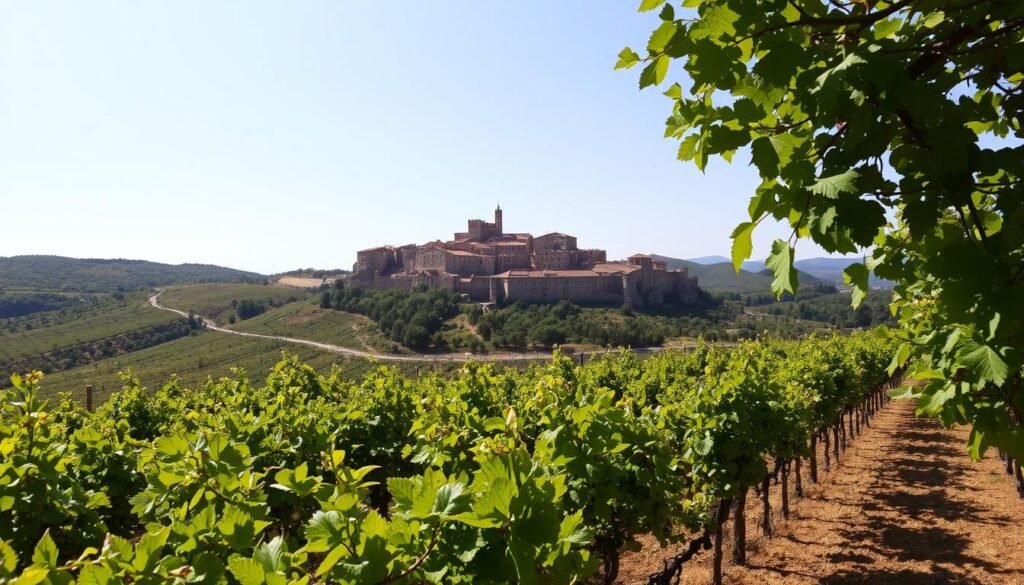
“Our vines drink the same sun and minerals as the vegetables in your plate,” explains a winemaker. She pours a 2022 red from her organic vineyard. The Grenache-based blend’s dark cherry intensity match the slow-cooked rabbit stew sampled earlier—a lesson in terroir harmony.
A table below captures pairings that have been tested:
| Wine | Pairing Highlight | Producer |
|---|---|---|
| Biodynamic rosé | Fish soups with saffron | Domaine de Manville |
| Mistral-influenced red | Garlic beef daube | Château Simone |
| Marsanne-Roussanne blend | Herb-crusted goat cheese | Domaine des Fonts |
Recreating these moments at home? Seek Domaine Tempier’s Bandol rosé for bouillabaisse. For rustic reds, Clos Ciboule’s Mourvèdre matches hearty stews. When Provençal wines are hard to find, New World wines from similar climates can work too.
Beyond the Restaurant: Food Markets and Artisanal Producers
Stepping beyond Les Baux’s cliffside tables, the Provence food markets and hidden workshops of local artisans reveal the soul of Provençal gastronomy. Every Wednesday, the village square becomes a living tapestry of French artisanal producers. Sun-ripened tomatoes glisten beside baskets of wild fennel, and the air hums with Provençal dialect. Farmers greet visitors with soil-streaked hands, often giving samples of figs warm from the sun.
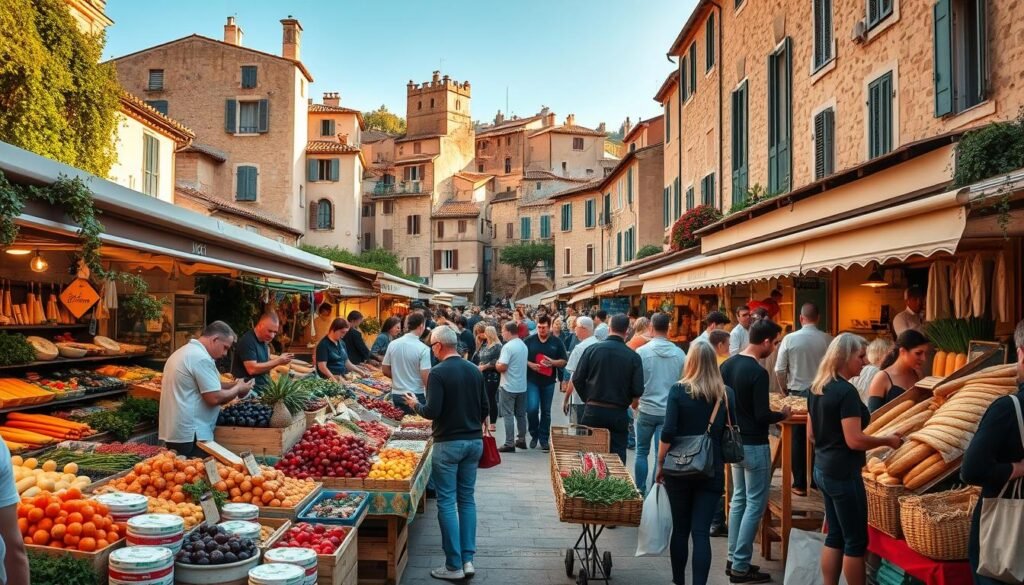
Wednesday Market Days: A Sensory Experience
Begin your mornings here, tracing paths between stalls where Provençal cheese and charcuterie dominate. The affineur at Fromagerie La Vallée des Baux invites guests to taste banon—chevre wrapped in chestnut leaves—a tradition dating to Roman times. Nearby, the Curé de Prades charcuterie stall showcases saucisson air-dried in stone cellars, their flavors deepened by centuries-old methods.
Fromageries and Charcuteries Worth Seeking Out
Producers like Charcuterie Peyraube embody Provençal resilience. Their sochon (blood sausage) blends pork with wild fennel, a recipe unchanged for over a century. Below is a guide to essential stops:
| Producer | Specialty | Highlight |
|---|---|---|
| Fromagerie La Vallée des Baux | Banon cheese | Chestnut-leaf-wrapped goat cheese |
| Charcuterie Peyraube | Traditional sausages | 1897 family recipe with wild fennel |
Artisanal Sweet Treats and Pastries
Ending the day at Boulangerie du Rempart, watch almond-fragrant calissons take shape—almond paste wrapped in crystallized melon. Nearby, La Mie Cuite crafts honey cakes infused with rosemary from the Alpilles. The patissiers’ hands move like alchemists, turning lavender honey and almonds into edible poetry.
- Arrive early for fresh-baked bread and morning dew-kissed vegetables
- Ask vendors about their “secret” stall—many offer tastings for curious travelers
- Respect the “no samples” rule at charcuterie counters to avoid cross-contamination
The Price of Panorama: Value Assessment of High-End Dining Experiences
A meal at Michelin-starred restaurant in Les Baux-de-Provence is most memorable. The gourmet meal cost analysis shows more than just the menu prices. A 12-course tasting menu, at €200 per person, is a feast of flavors. It includes truffle soups, lamb from local farms, and desserts that feel like art.
The real value is in the experience, not just the price. The sommelier pairs a simple rosé with each dish, showing great skill. The servers know all about the Provençal origins of each dish. And the view of the Alpilles peaks at sunset is breathtaking. This is true fine a dining value in France.
Luxury doesn’t have to be expensive. At a hidden bistro, order a roasted rabbit with lavender honey for €18. It is a surprise in luxury restaurant prices of Provence’s secret spots. The chef believes in using quality ingredients, not just big portions.
He shares his thoughts with a winemaker. The winemaker said, “Olive oil here costs more, but it’s worth it. It honors our tradition.”
- Choose weekday lunch menus at flagship restaurants, often 40% cheaper than dinner
- Visit in May or October—shoulder season discounts on multi-course meals
- Pair high-end dinners with market-day breakfasts at the Wednesday morning stalls
A local sommelier once said,
“Here, every euro spent on a meal is an investment in stories yet untold.”
The secret is to be intentional with your choices. Whether it’s a €100 truffle risotto or a €5 cheese board, Les Baux’s culinary heart beats strongest with thoughtful decisions.
When to Visit: Seasonal Variations in Les Baux’s Culinary Scene
Deciding when to visit Provence for food depends on what you’re in the mood for. Each season in Les Baux-de-Provence brings its own unique flavors. Explore all four seasons and find moments that show the heart of this place.
Spring Harvest Celebrations
In April, the Fête de l’Huile Nouvelle fills the air with joy. People gather under olive trees to share meals. They pour new olive oil over artichokes and salads, creating a scene filled with laughter and thyme.
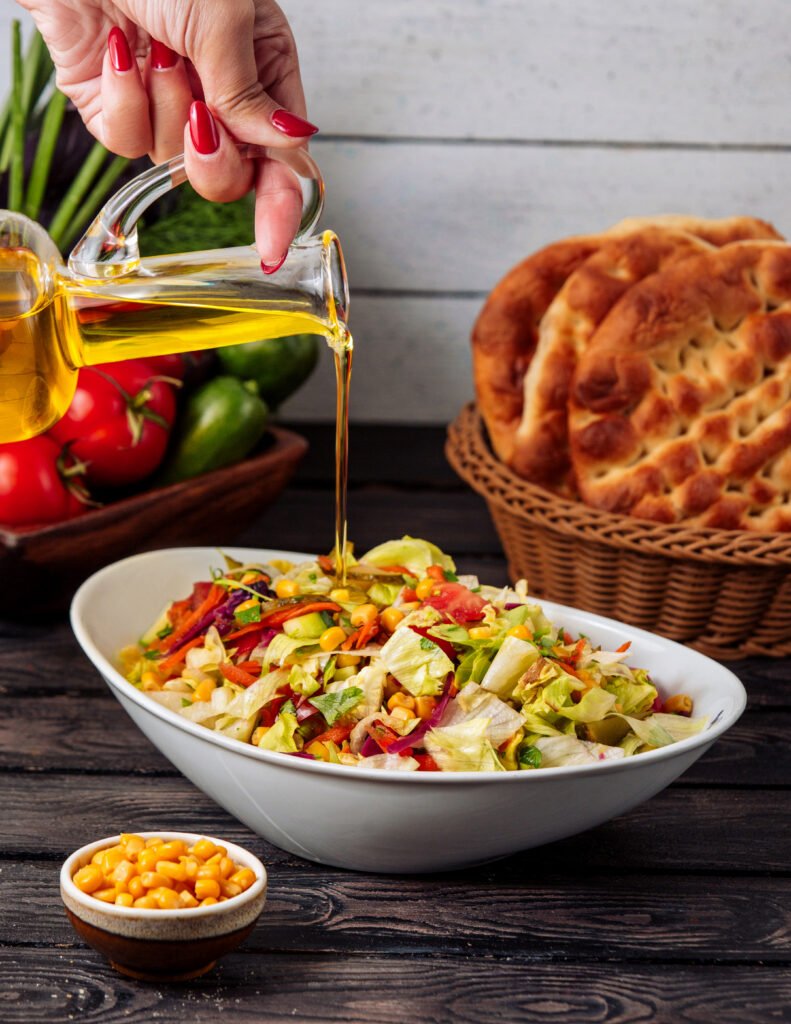
Spring brings short-lived treats like fiddlehead ferns and violet asparagus. These are rare finds on menus, making April to June a time for food enthusiasts to explore.
Summer Evening Dining Under the Stars
When the sun sets, tables appear in lavender fields. Enjoy meals at L’Oustau de Baumanière, with waiters serving rosemary-roasted lamb and fig compote. The sky is a backdrop of stars, untouched by city lights.
Summer’s warmth calls for light dishes like chilled melon soups with basil. These are best savored on terraces, where cicadas play a symphony.
Fall and Winter: Truffle Season and Hearty Fare
November brings truffle season to Provence. Chefs at Le Mas d’Aigret lead truffle hunts. Explore once through misty woods with a truffle-hunting pig.
Later, at a farmhouse, you can enjoy vin rouge while a chef shave truffles over pappardelle. Winter brings daubes, slow-cooked stews with garlic and thyme. For a taste of this, try this truffle-infused popcorn recipe.
Conclusion: The Lasting Impressions of Les Baux-de-Provence’s Gastronomic Landscape
Les Baux-de-Provence shows you that food in France is more than just eating. It’s a mix of history, land, and people’s skills. When you taste AOP olive oil, its strong flavor remind you of farmers’ long traditions.
Every bite became a way to connect with a culture’s heart. This changes how you see food. It’s not just about taste; it’s about the stories behind it.
In Provence, meals are special because of where they’re eaten. A tomato salad at sunset, with a medieval village in the background, taste amazing. The cliffs adds to the flavor, making meals more than just food.
Les Baux-de-Provence is all about taking your time. Meals are set by the seasons, not by a clock. You’ll now enjoy waiting for winter truffles or summer figs, just like the chefs here.
The region’s artisans, like bakers and truffle hunters, are very important. They keep traditions alive. Their work is not just about food; it’s about preserving a way of life.
For real culinary adventures, check out Epicurean Escape. They offer trips that respect local traditions. Supporting these efforts helps keep Les Baux’s food culture alive.
Your trip home will be filled with more than just photos.You’ll come back hungry to cook with purpose Support local farmers and let the landscape enhance your cooking.
The cliffs of Provence may look impressive, but the real beauty is in the hands that make its food. Culinary tourism here is not just a list of things to do. It’s an invitation to enjoy the stories in every olive and every bite of socca. Eating in Les Baux is like tasting time itself, and travelers become part of its legacy.
